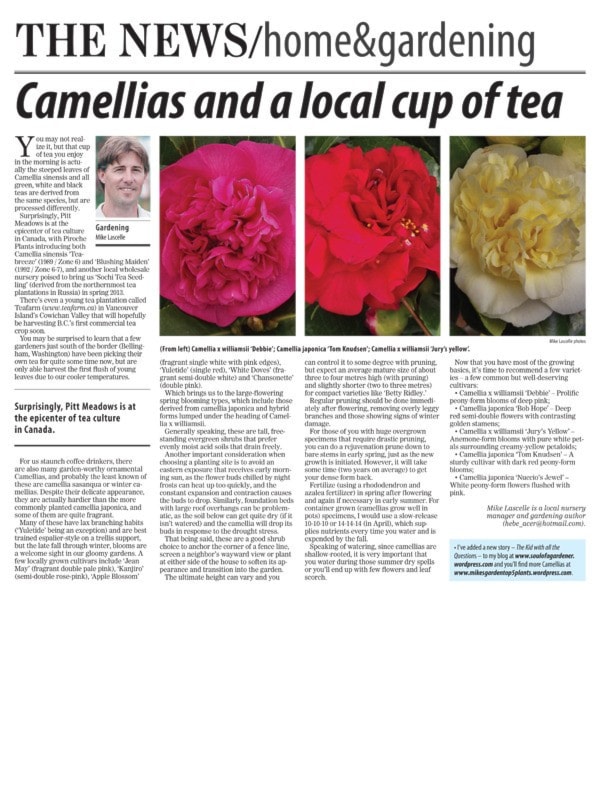You may not realize it, but that cup of tea you enjoy in the morning is actually the steeped leaves of Camellia sinensis and all green, white and black teas are derived from the same species, but are processed differently.
Surprisingly, Pitt Meadows is at the epicenter of tea culture in Canada, with Piroche Plants introducing both Camellia sinensis ‘Teabreeze’ (1989 / Zone 6) and ‘Blushing Maiden’ (1992 / Zone 6-7), and another local wholesale nursery poised to bring us ‘Sochi Tea Seedling’ (derived from the northernmost tea plantations in Russia) in spring 2013.
There’s even a young tea plantation called Teafarm (www.teafarm.ca) in Vancouver Island’s Cowichan Valley that will hopefully be harvesting B.C.’s first commercial tea crop soon.
You may be surprised to learn that a few gardeners just south of the border (Bellingham, Washington) have been picking their own tea for quite some time now, but are only able harvest the first flush of young leaves due to our cooler temperatures.
For us staunch coffee drinkers, there are also many garden-worthy ornamental Camellias, and probably the least known of these are camellia sasanqua or winter camellias. Despite their delicate appearance, they are actually hardier than the more commonly planted camellia japonica, and some of them are quite fragrant.
Many of these have lax branching habits (‘Yuletide’ being an exception) and are best trained espalier-style on a trellis support, but the late fall through winter, blooms are a welcome sight in our gloomy gardens. A few locally grown cultivars include ‘Jean May’ (fragrant double pale pink), ‘Kanjiro’ (semi-double rose-pink), ‘Apple Blossom’ (fragrant single white with pink edges), ‘Yuletide’ (single red), ‘White Doves’ (fragrant semi-double white) and ‘Chansonette’ (double pink).
Which brings us to the large-flowering spring blooming types, which include those derived from camellia japonica and hybrid forms lumped under the heading of Camellia x williamsii.
Generally speaking, these are tall, free-standing evergreen shrubs that prefer evenly moist acid soils that drain freely.
Another important consideration when choosing a planting site is to avoid an eastern exposure that receives early morning sun, as the flower buds chilled by night frosts can heat up too quickly, and the constant expansion and contraction causes the buds to drop. Similarly, foundation beds with large roof overhangs can be problematic, as the soil below can get quite dry (if it isn’t watered) and the camellia will drop its buds in response to the drought stress.
That being said, these are a good shrub choice to anchor the corner of a fence line, screen a neighbor’s wayward view or plant at either side of the house to soften its appearance and transition into the garden.
The ultimate height can vary and you can control it to some degree with pruning, but expect an average mature size of about three to four metres high (with pruning) and slightly shorter (two to three metres) for compact varieties like ‘Betty Ridley.’
Regular pruning should be done immediately after flowering, removing overly leggy branches and those showing signs of winter damage.
For those of you with huge overgrown specimens that require drastic pruning, you can do a rejuvenation prune down to bare stems in early spring, just as the new growth is initiated. However, it will take some time (two years on average) to get your dense form back.
Fertilize (using a rhododendron and azalea fertilizer) in spring after flowering and again if necessary in early summer. For container grown (camellias grow well in pots) specimens, I would use a slow-release 10-10-10 or 14-14-14 (in April), which supplies nutrients every time you water and is expended by the fall.
Speaking of watering, since camellias are shallow-rooted, it is very important that you water during those summer dry spells or you’ll end up with few flowers and leaf scorch.
Now that you have most of the growing basics, it’s time to recommend a few varieties – a few common but well-deserving cultivars:
• Camellia x williamsii ‘Debbie’ – Prolific peony-form blooms of deep pink;
• Camellia japonica ‘Bob Hope’ – Deep red semi-double flowers with contrasting golden stamens;
• Camellia x williamsii ‘Jury’s Yellow’ – Anemone-form blooms with pure white petals surrounding creamy-yellow petaloids;
• Camellia japonica ‘Tom Knudsen’ – A sturdy cultivar with dark red peony-form blooms;
• Camellia japonica ‘Nuccio’s Jewel’ – White peony-form flowers flushed with pink.
Mike Lascelle is a local nursery manager and gardening author. Email him at hebe_acer@hotmail.com.
Blog
Mike has a new story on his blog Soul of A Gardener - The Kid with all the Questions and you’ll find more Camellias at www.mikesgardentop5plants.wordpress.com.
